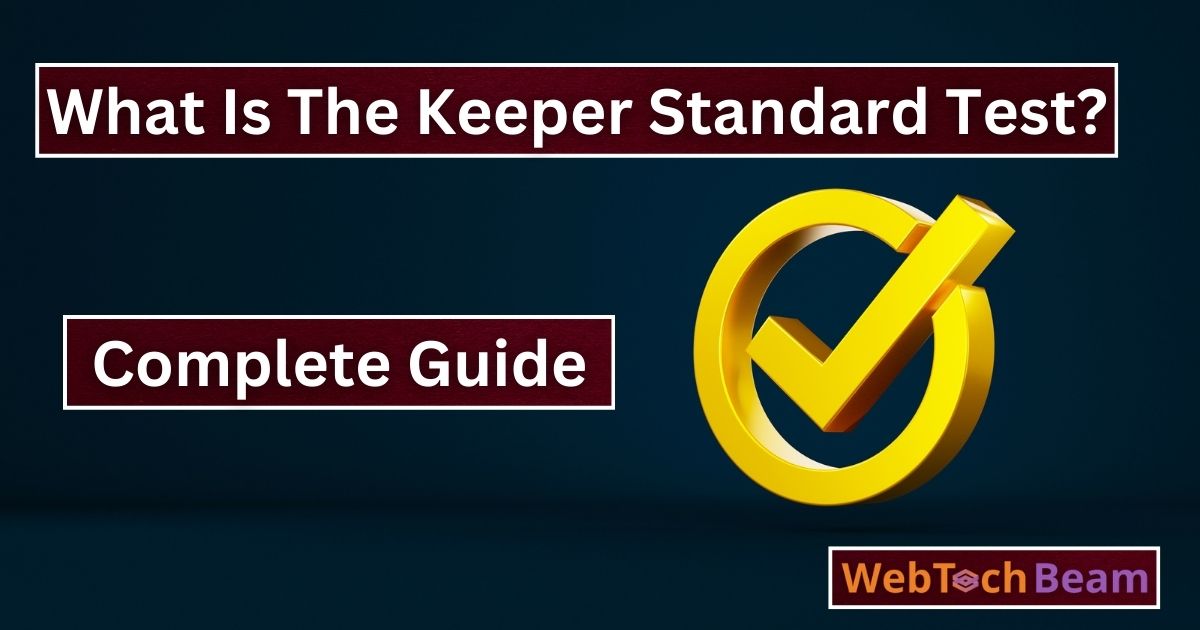Introduction to the Keeper Standard Test
In today’s fast-paced work environment, organizations are constantly on the lookout for innovative ways to assess their talent and improve overall performance. One such method gaining traction is the Keeper Standard Test. But what exactly does this test entail? Why has it become a critical tool for both employers and employees alike? As companies strive to enhance productivity while fostering employee satisfaction, understanding the Keeper Standard Test’s intricacies can unlock new pathways to success. Dive in with us as we explore its history, significance, and numerous benefits that make it an essential component of modern organizational strategy.
History and development of the test
The Keeper Standard Test has evolved significantly since its inception. Initially designed to evaluate cognitive abilities, the test’s scope broadened over time to encompass emotional intelligence and practical skills.
Developed in the late 20th century, it aimed to address gaps in traditional assessment methods. The early iterations focused primarily on academic performance but soon recognized that character traits and interpersonal skills were equally vital for success.
As workplaces became more dynamic, the test adapted accordingly. Researchers collaborated with industry leaders to refine its components, ensuring relevance across various sectors.
This evolution reflects a growing understanding of what constitutes effective leadership and teamwork. Today’s version emphasizes not just individual competencies but also collaborative potential within teams.
Each update incorporated feedback from users, making the Keeper Standard Test a responsive tool for measuring employee capabilities in real-world scenarios.
How the test works and what it measures
The Keeper Standard Test employs a series of assessments designed to evaluate an individual’s skills and competencies in the workplace. It focuses on critical thinking, problem-solving abilities, and interpersonal skills.
Participants engage in various scenarios that mimic real-world challenges they might face on the job. These scenarios are crafted to measure both cognitive capabilities and emotional intelligence.
Through this process, employers gain insights into how candidates approach tasks under pressure. The test also assesses adaptability—an essential trait for today’s fast-paced work environment.
Moreover, it captures behavioral tendencies that indicate how individuals collaborate within teams. This multifaceted approach ensures a comprehensive evaluation of each candidate’s potential fit for specific roles or organizational culture.
By collecting data from these diverse areas, organizations can make informed decisions about hiring and development strategies.
Importance of the Keeper Standard Test
The Keeper Standard Test plays a crucial role in assessing employee competencies. It helps organizations identify strengths and weaknesses within their teams.
By providing clear benchmarks, this test enhances the recruitment process. Employers can make informed decisions based on data-driven insights rather than gut feelings alone.
Additionally, the Keeper Standard Test fosters continuous improvement. Regular assessments help employees track their progress and develop skills over time.
This proactive approach not only boosts individual performance but also aligns with organizational goals. When everyone is on the same page, teamwork flourishes.
Moreover, it enhances job satisfaction by ensuring that employees feel valued for their contributions. This leads to higher retention rates and a positive workplace culture.
Organizations that prioritize testing gain a competitive edge in talent management. The focus shifts from merely filling positions to nurturing growth-oriented environments where both individuals and companies thrive.
Benefits for employers and employees
The Keeper Standard Test offers significant advantages for both employers and employees. For organizations, it helps identify key talent and potential leaders within the workforce. This insight allows companies to invest in their most promising individuals.
Employees benefit by gaining clarity on their strengths and areas for growth. The test fosters personal development, empowering them to take charge of their career paths.
Moreover, having a structured assessment can enhance team dynamics. When everyone understands each other’s skills, collaboration improves significantly.
Employers see increased retention rates as employees feel valued through personalized growth opportunities. A motivated workforce translates into higher productivity and morale across the organization.
Implementing this test creates an environment where both parties thrive—leading to long-term success for the company while nurturing individual aspirations.
How to prepare for the test
Preparing for the Keeper Standard Test requires a strategic approach. Start by familiarizing yourself with the test format and its components. Knowing what to expect can ease anxiety and enhance performance.
Engage in practice assessments that mirror actual test questions. This will not only boost your confidence but also help you identify areas needing improvement.
Consider forming a study group with peers who are also preparing for the test. Sharing insights and discussing concepts can deepen understanding.
Incorporate regular breaks into your study schedule to prevent burnout. Keeping your mind fresh is crucial for optimal retention of information.
Ensure you get adequate rest before the test day. A well-rested mind performs significantly better than one fatigued from last-minute cramming or stress.
The Purpose and Importance of the Keeper Standard Test
The Keeper Standard Test serves a crucial purpose in the landscape of employee evaluation. It provides organizations with an objective method to assess individual performance and potential. Through this standardized approach, employers gain valuable insights into their workforce.
Understanding how employees fit within their roles can lead to more informed decision-making. The test highlights strengths and areas for improvement, guiding professional development initiatives.
Moreover, it fosters a culture of transparency and accountability within teams. Employees appreciate knowing that evaluations are based on consistent criteria rather than subjective opinions.
In an era where talent retention is paramount, the Keeper Standard Test also aids in identifying key players who drive organizational success. By recognizing top performers, companies can strategize better retention efforts and enhance job satisfaction overall.
Understanding the Components of the Keeper Standard Test
The Keeper Standard Test is a multifaceted evaluation designed to assess various competencies in the workplace. It primarily focuses on behavioral traits, cognitive abilities, and emotional intelligence.
One key component of the test measures problem-solving skills through situational judgment scenarios. Candidates face realistic work-related challenges that reveal their thought processes and decision-making approaches.
Another important aspect evaluates communication styles. This part examines how individuals articulate thoughts and ideas in team settings, helping employers understand interpersonal dynamics better.
The test assesses adaptability by presenting unforeseen changes or challenges. Participants who can navigate these situations demonstrate resilience—a crucial trait for any organization aiming for success in today’s fast-paced environment. Each element contributes to a holistic view of an employee’s potential fit within a company culture.
Benefits of Implementing the Keeper Standard Test
Implementing the Keeper Standard Test offers a multitude of advantages for organizations. It creates a clear framework to assess employee performance, ensuring that everyone understands the expectations.
This test fosters an environment of accountability. Employees become more aware of their roles and responsibilities, driving them to improve continuously.
Additionally, it provides valuable data for decision-making processes. Leaders can identify strengths and weaknesses within teams, allowing for targeted development initiatives.
The Keeper Standard Test also enhances communication between management and staff. Regular assessments facilitate constructive feedback conversations that ultimately lead to personal growth.
Moreover, this standardized approach promotes fairness in evaluations. It minimizes biases by focusing on measurable outcomes rather than subjective opinions, creating trust across all levels of the organization.
Organizations that adopt this test often experience improved morale as employees see tangible evidence of their progress and contributions recognized through systematic evaluation methods.
Real-life Examples of How the Keeper Standard Test Has Improved Organizations
Organizations across various industries have embraced the Keeper Standard Test, experiencing notable improvements. In a tech company, implementing this test enhanced team collaboration. Employees reported feeling more valued and engaged in their roles.
A healthcare provider utilized the Keeper Standard Test to refine its hiring process. They discovered candidates who aligned with their core values led to better patient care and staff satisfaction.
In retail, a major brand adopted the test during training programs. This resulted in lower turnover rates as employees felt they were part of a cohesive team that understood their capabilities and goals.
Moreover, a financial institution witnessed increased productivity after integrating the Keeper Standard Test into performance evaluations. Staff members became more committed to personal development plans tailored to their strengths identified through the test.
These real-life examples highlight how organizations can thrive by recognizing individual potential through effective assessment tools like the Keeper Standard Test.
How to Take the Keeper Standard Test and What to Expect
Taking the Keeper Standard Test is a straightforward process designed to assess various competencies in employees. The test typically involves both written and practical components, allowing for a well-rounded evaluation.
Participants can expect a series of questions that focus on specific skills relevant to their job functions. These may include problem-solving scenarios, communication tasks, and teamwork exercises.
Before the test day, it’s advisable to review any provided materials or guidelines from your employer. Familiarizing yourself with potential topics can boost confidence and performance.
On the day of the test, ensure you arrive early to settle in without rushing. A calm mindset will help you focus better during each segment.
The testing environment usually promotes concentration, so distractions are minimized. Expect clear instructions from facilitators who aim to support every participant throughout the assessment process.
Conclusion: Why Every Organization Should Consider Using the Keeper Standard Test
The Keeper Standard Test offers a comprehensive approach to evaluating employee performance and potential. By measuring key competencies, it provides valuable insights that can drive organizational success. The test is not just a one-time assessment; it fosters ongoing development for both employers and employees.
Organizations looking to enhance their workforce should consider implementing the Keeper Standard Test. It aligns with modern workplace needs, focusing on continual improvement rather than mere evaluation. This proactive stance helps build a more engaged and competent team.
Adopting this test can lead to numerous benefits including better retention rates, improved productivity, and a stronger company culture. With its proven track record of enhancing individual capabilities and promoting collective growth within teams, it’s clear why many organizations are embracing the Keeper Standard Test as an essential tool in their development strategy. Prioritizing such assessments can set the foundation for long-term success in any industry.
















